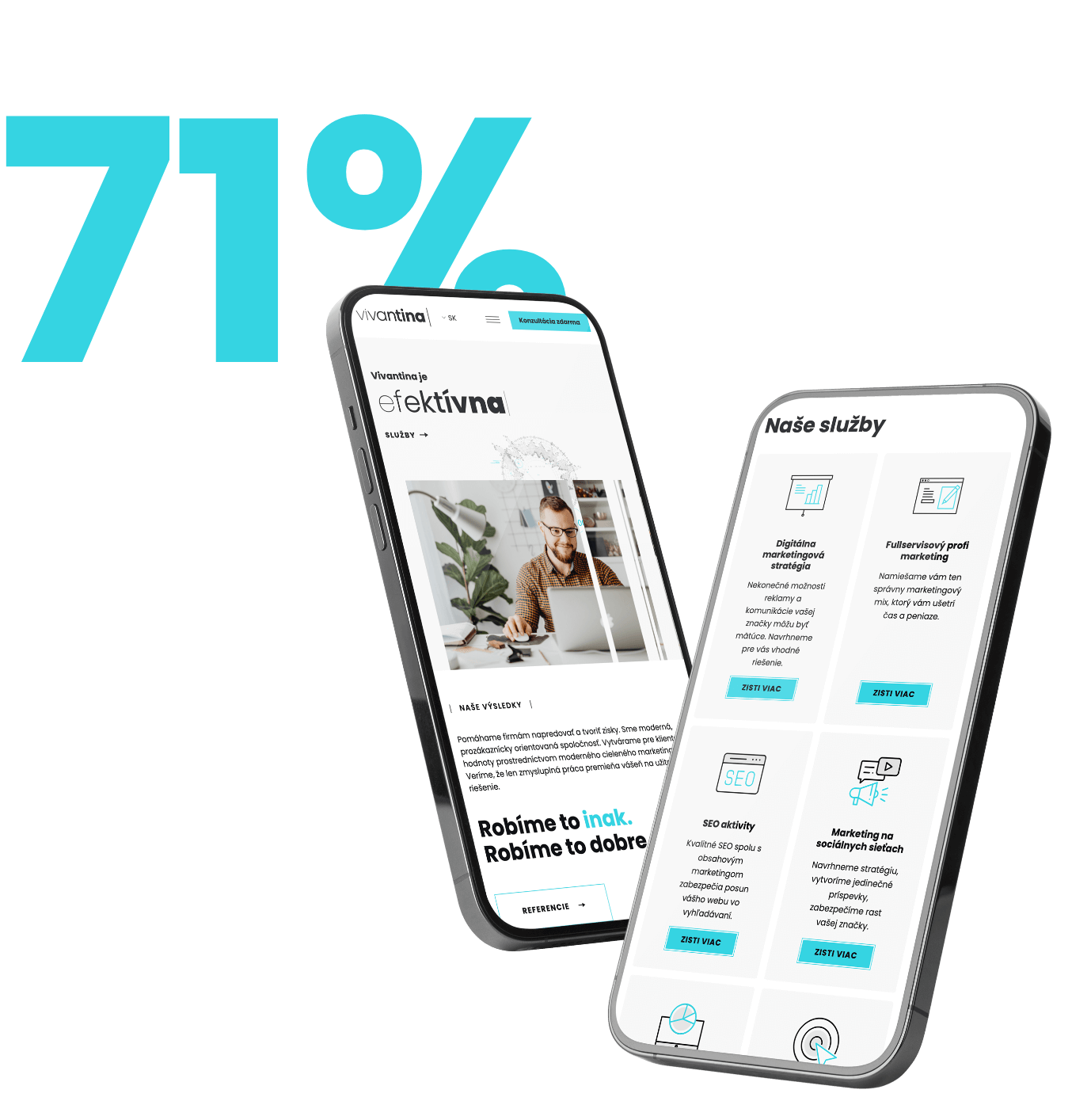Perhaps you know this yourself.
You have set up an e-shop, have a great product, but at some point, you've stalled and don't know what to do next. What type of advertising should you invest money in? Is it worthwhile to have a blog to improve SEO? Why is your e-shop not selling when traffic is increasing? And what to do about big competitors whose prices you can't match?
For newcomers to the e-commerce world, marketing often becomes a source of frustration, as you will encounter problems that you may not have had any idea about initially. Let's introduce the biggest marketing challenges for startup e-shops.
Problem #1
E-shop is insufficient traffic and visibility
One of the biggest problems you will inevitably face as a new e-shop is insufficient traffic and visibility. Just like in a brick-and-mortar store, traffic directly affects the number of potential customers. Low traffic leads to reduced sales and hampers business growth.
Visibility, which depends on SEO optimization and online advertising and promotion, determines how easily customers can find an e-shop
Without quality SEO, an e-shop relies on paid advertising and loses the potential for organic search.
The utmost key to success is therefore investing in SEO optimization, which includes keyword analysis, creating top-notch content, and technical website adjustments. Simultaneously with optimization, it's advisable to launch PPC advertising and build awareness of the e-shop on social media.

Problem #2
The website is not selling as needed
Experts have a clear term for this problem: “weak conversion rate optimization.” Even if you manage to attract visitors to your website, it doesn't automatically mean sales. A low conversion rate means that many people visit your site, but few actually make a purchase.
It can have several reasons: from a bad first impression caused by a cluttered and slow-loading website to complicated navigation, a complex purchase process, high prices, missing product information, concerns about payment security on an unfamiliar e-shop, and overall brand unawareness.
What to do about it?
First, you need to simplify the website and purchase process. Improving product descriptions and photos, displaying reviews and encouraging their submission, offering secure payment methods, and clearly communicating delivery and return terms will also help. Motivate purchases also with discounts, gifts, loyalty programs, or free shipping.
Problem #3
Struggling to surpass competition without lowering prices
As a startup e-shop, you will face huge competition from well-known stores that have the advantage of a familiar brand, a wider range of products, better prices, and superior customer service. To succeed, it's not enough just to lower prices. Instead of price competition, focus on building your own identity.
Offer unique products that big brands overlook (and for which you can charge more), specialize in a specific market segment, and provide exceptional customer service. In terms of marketing, you can try various creative and low-budget strategies, such as viral videos or collaborations with micro influencers, which may surprise you with their return on investment.
Problem #4
Not knowing how to retain customers who have already purchased from you
Acquiring customers is just the first step. It's even more important to maintain their loyalty and turn them into repeat buyers. If customers purchase from you once and don't return, we refer to it as low retention. For an e-shop, low retention is an issue because acquiring new customers is far more expensive and demanding than maintaining existing ones. On the other hand, high retention brings many advantages. Customers who shop with you repeatedly spend more money, are more loyal, and less likely to switch to competitors. Additionally, they leave positive reviews, contributing to building a good reputation.
There are several ways to improve customer retention in an e-shop. You can reward repeated purchases, offer special promotions and benefits to loyal customers. Offer a discount or gift for signing up for a newsletter, send personalized emails. Automation of email campaigns can help with this.
Tell us about your project.
Do you want to use the power & drive of practical online marketing? We are the number one choice for companies that want to move forward.
Problem #5
Not knowing how to allocate the budget for marketing
The biggest and most common mistake startup e-shops make when allocating the budget for online marketing is "shooting blind" and scattering resources. Many starting e-shops try a bit of Google Ads, a bit of Facebook Ads, a bit of influencer marketing, but they don't know what actually brings them results. As a result, money is spent on activities that don't bring sufficient profit, and you lose motivation to keep doing business.
Avoid this mistake and prioritize activities with the highest return on investment (ROI) as soon as possible.
Be aware that there is no universal set-up, no matter how much you "Google." Simply, you need to focus on those marketing activities that bring the most profit compared to the costs incurred specifically for you.
Marketing solutions for starting e-shops from VIVANTINA
SEO optimization for e-shops: gain traffic without advertising costs
Studies show that up to 53% of all website traffic comes from organic search (Bright Edge).

For starting e-shops with lower budgets, SEO is important because it offers a long-term return on investment without the need to constantly invest in ads. SEO activities also include content marketing: writing blogs, guides, reviews, and creating detailed product descriptions optimized for long-tail keywords.
You may be surprised, but even in an age dominated by video, the blog is not dead yet. It turns out that companies that manage a blog gain 57% more visitors, 97% more inbound links, and have 434% more indexed pages than companies that don't have one. (Higher Visibility) Good SEO also relies on backlinks from reliable sources that increase the authority of your e-shop. According to Backlinko, on average, the first result on Google typically has 3.8 times more backlinks than results in positions 2 - 10.
A practical example
+ 57 %
more visitors thanks to the blog
+ 97 %
more incoming messages
3,8 x
more backlinks
This means you need link building badly, whether you're selling toothbrushes or nutritional supplements.
Increase in organic traffic for an online marketplace

A case study from The Hoth shows the significant role of link building in setting up the right SEO strategy—that is, backlinks from other trustworthy websites to your site. An agency solving the problem of low traffic to an online marketplace for shoes and clothing decided, after an SEO audit, to focus primarily on building strong authority in Google. They used two main strategies to gain links.
Firstly, they wrote articles for other fashion-themed websites and in these articles, linked back to the client's website. Secondly, they built long-term relationships with other websites, commented on their posts, and showed appreciation for their content. This way, they gained additional links. After a year, the marketplace achieved a 100% increase in organic traffic and a significant improvement in search positions. Furthermore, due to the cumulative effect of SEO, it's expected that traffic will continue to grow in the future.
Start fine-tuning your SEO with Vivantina
However, SEO is not a magical powder that you sprinkle into the marketing mix, stir, and that's it. It is more like a marathon that requires long ant-like work. The best companies do this process continuously and have been doing it for years. Find out how we handle SEO activities at Vivantina and how we can help you get to the top positions in Google.

Pave your way to a love brand thanks to social networks
Social networks are an invaluable tool for reaching your target audience. Be aware that today, they are not just playgrounds for entertainment but also starting points from which the customer journey to purchase begins. According to a Global Web Index survey, nearly 3 in 10 users cite product discovery online as the main reason for using social media, and 71% of consumers who have a positive experience with a brand on social media are more likely to make a purchase.
A Sprout Social study shows that when customers feel connected to brands, more than half of consumers (57%) will increase their spending on that brand.
This is enormous potential.
The younger generation is especially changing the rules of the game. According to Sprout Social, in 2022, almost 40% of Generation Z preferred TikTok over Google for information searching. For you as a starting e-shop, this means that social networks are also a sales channel. They also help you make an impression, even if you are a small and start-up e-shop.
40%
Generation Z preferred TikTok over Google

A Practical Example: From a Small Cosmetics Company to a Giant
ColourPop, a cosmetics company founded in 2014, has grown from a small and unknown business to a brand with an annual turnover of over $70 million. Its success is analysed in a case study by Opti Monk. It is largely based on a clever social media strategy, which consisted of four key steps:
Process program
This strategy helped them build a strong online community and significantly increase brand awareness, which resulted in impressive growth and financial success.
Unlock the Full Potential of Social Media for Your E-Shop
If you want to use social media strategically and to its full potential, order social media management from Vivantina. In addition to managing your social media, we will also show you how to properly measure and evaluate your social media activities.
PPC Advertising: Reach your target audience and convert them into customers
According to Data Box statistics, three types of PPC ads dominate in the e-commerce segment: ads on Google, Facebook, and Instagram. From experience, we know that for a new e-shop, the most effective choice is often a combination of search ads and retargeting.
Search ads in the Google Ads platform
Search ads in the Google Ads platform are those that appear on the Google search results page when you search for something. As Word Stream reports, they achieve an average click-through rate (CTR) of around 2.69% in the e-commerce segment, making them a very effective tool to reach customers actively searching for products. For e-shops with physical products, we also recommend considering shopping ads on Google, which Data Feed Watch identifies as an effective tool with an average CTR of 0.86%. (These are the ads that look like small product images with the price and store name. They appear above or next to search results when you search for a product.)
± 2,69%
average click-through rate (CTR)
Retargeting campaigns
Retargeting campaigns in search ads focus on people who have visited your website in the past. Among online ads, they belong to the most effective. Demands Age statistics show they can help increase the conversion rate by 150%. This means that if your regular search campaign led to, for example, 100 conversions (purchases), a retargeting campaign could bring as many as 250 conversions. According to Demands Age, 80% of marketers use them to win back their consumers.
+ 150%
increase conversion rates
A Practical Example: 60% More Revenue for a Pharmacy E-Shop
A case study by Mashup Digital demonstrates that PPC advertising is a dynamic process that needs to be understood and constantly optimized to achieve the best return on investment. A pharmacy e-shop, which sells everything from dermo cosmetics to various dietary supplements and pet medicines, faced the challenge of increasing revenue. Mashup Digital analysed the data and discovered that there were significant opportunities in PPC advertising. They literally “reworked” the PPC ads for the client from scratch.
Instead of “throwing” all the client's ads into one large campaign, the agency divided them into logical units. They created separate campaigns for individual brands and within those, ad groups for different product categories or target audiences.
Each ad group was thus targeted at a specific audience with the right messaging and ad formats. Thanks to this strategy, the pharmacy e-shop’s traffic via Google Ads increased by almost 30%, while maintaining return on investment. The e-shop's revenue grew by 60% compared to the same period last year. As you can see from this example, when two people do the same thing, the results may not always be the same.

Don't Spend Your Budget Blindly - Let Us Handle Your PPC Ads
At Vivantina, we will set up your PPC ads so you can fully focus on your business without having to deal with things you’re not entirely familiar with.
Our goal is to make sure your campaigns deliver the best results with the lowest possible investment in credit.

Setting Up Google Analytics: Measure Twice, Cut Once
Google Analytics is a key tool for new e-shops as it allows for detailed analysis of visitor behaviour on your website. With it, you can discover which pages are most frequently viewed by visitors and at which point the customers are dropping out of the shopping process. It also lets you track which campaigns bring the most visitors and sales. With this data, you can make more efficient decisions about campaigns and budgets. This approach is also called data-driven marketing.

Why Should You Use Analytical Tools in Your Marketing?
According to statistics from Think with Google, nearly two-thirds of top marketers claim that data-driven decisions are better than those based on instinct. Instinct can mislead you, but data always tells the truth.
By analysing data, you can more effectively allocate your budget and prioritize the channels with the highest ROI. Knowing how to interpret data from Google Analytics is now essential for e-shops; otherwise, you may be wasting money.
A Practical Example: How analytics help you make better decisions

The final example in our case studies is from Kinga Dow.
This e-commerce business was struggling with poor website efficiency. Customers quickly left the site and didn’t complete their purchases. To improve this, the agency used Google Analytics to conduct a detailed analysis of the website. They started tracking key metrics (such as bounce rate, traffic sources, and individual page performance).
Using this data, they identified problem areas and made several important decisions. One of these was investing in Google shopping ads, which began generating revenue almost immediately. Through various adjustments, continuous data analysis, and testing, they managed to reduce the bounce rate and increase conversions (completed purchases) by 28%. This led to a significant revenue increase for the e-shop. This example shows how Google Analytics helps understand customer behaviour on the website and identify areas that need improvement. Without Google Analytics, the e-shop wouldn’t know where its weak points are. And if you don’t know your weaknesses, it’s difficult to grow and achieve better results.
Vivantina will not only set up Google Analytics but will also give you the best training
You too can leverage Google Analytics 4 set-up to improve your e-shop. Learn how to analyse data and understand how your website is performing. With this, you’ll identify issues and know where to invest your efforts to achieve the best results.
Why Entrust Your E-Shop Marketing to Vivantina?
Have the solutions mentioned above appealed to you? Put your marketing in our hands and we will find them for you and your real estate agency.
8
rokov skúseností
40+
stálych zákazníkov
1 mil.
eur ročne
10
členný tím
As a certified Google partner with over ten years of experience, we manage campaigns for more than 40 long-term clients, not just in Slovakia, but also in 8 foreign countries. We handle a budget exceeding 1 million euros annually.


